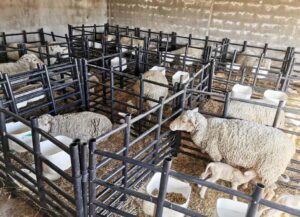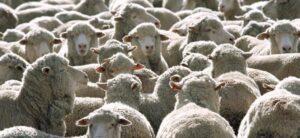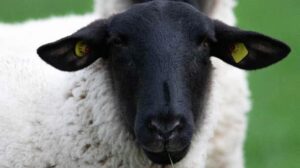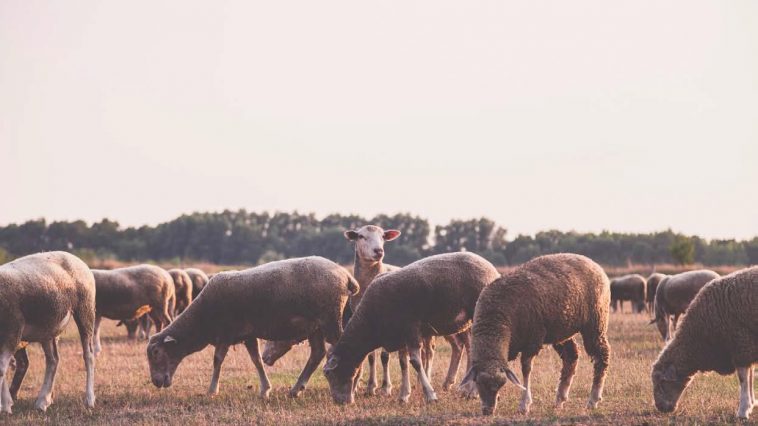Sheep production is becoming more popular in Southern Africa and the prices of small stock are increasing at livestock auctions.
The success of small stock farming rests on the implementation of critical management practices to effectively meet the animal’s nutritional and health needs for each growth phase. To produce mutton economically, it is necessary to comply with certain basic production requirements. Various closely related factors have an influence on the production process. Optimal production is only possible if all these factors assert their influence separately and combined.
Extensive vs Intensive production units
The design of an intensive production system is discussed according to a planning procedure, the climatic requirements, design specifications and choice of the site based on practical information, especially regarding the layout of the system. The various facilities such as the sheep overnight facility, the handling complex and shearing sheds are fully discussed in respect of the layout and existing systems.
The most important production requirements are the following:
- The provision of efficient and effective holding and handling facilities
- The establishment of proven genetic material resulting in proven stock
- The provision of a nutritional standard of high quality
- A high standard of management
- Stable marketing facilities

Sheep in an intensive system are kept in a smaller and more localised area.
Existing production systems and the factors influencing choice of breed
Existing production systems for mutton production can be divided into two main groups, namely extensive and intensive systems. Other important aspects are the type, location and construction of fences and gates. Provision must be made for sufficient water drinking systems and supplementary feeding.
Extensive production systems
In an extensive production systems sheep live off the veld. Relevant structures, therefore, consist of drinking troughs, overnight facilities, and a handling complex.
Intensive production systems
The term intensive production is commonly used. To prevent any confusion, the term intensive system is defined as follows: Intensive sheep production is a system not defined under an extensive system and usually refers to a closed system, or a system which exists in a feeding pen or a production system from planted grazing or a combination thereof. The final choice between the systems will largely depend on the owner, farmer or client, and will therefore depend on preference, management level, existing facilities et cetera.
Choice of breed
The objective of any production system is maximising profit. It is therefore important that the choice of a breed will also be made with maximum profits in mind.
The term profit maximising refers to striving towards maximum income from mutton and/or wool production per ewe per year. Factors such as a personal preference for a certain breed are therefore excluded from this discussion.

Pay close attention to the marketing age of your breed of choice.
In line with the profit maximising objective, the following factors when choosing a type of breed are important:
Carcass quality
- Maximum meat for money
- High growth potential
- Excellent results in feedlot
- A good feed conversion ratio
Functional efficiency
- High fertility and reproduction tempo
- Adaptation of a breed to the specific region
- Excellent maternal characteristics
- Long breeding season
- Suitable for crossbreeding and purebred
Fertility
- Unlimited breeding cycle
- Early maturity
- High lambing and weaning percentage
- Non-selective eaters
- Excellent milk production
If a certain herd size is accepted, the above factors can be evaluated according to three basic factors for the increase of mutton production, namely:
herd structure, age structure and weaning percentage.

Herd structure
The herd structure pertains to the percentage of the division of breeding ewes, she-lambs, young ewes, and wethers. The analysis of the herd structure showed that an increase in breeding ewes has an especially important influence on the future mutton production of a herd.
Factors such as marketing age, mating age and number of breeding seasons per year – which is directly dependent on the breed – determine the percentage of breeding ewes in the herd. The greatest percentage of breeding ewes in the herd – and consequently the highest mutton production – is possible with breeds such as pure mutton breeds and crossbred mutton/wool breeds.
Age structure
Mutton production consists of the number of lambs and the number of ewes marketed annually. An extension of the period that breeding ewes can be used in the herd means a reduction in the replacement tempo, that is the number of lambs to be retained in the herd per year for replacement of productive ewes. A reduction in the replacement tempo will inevitably ensure an increase in the number of marketable lambs per year and hence an increase in income.
No universal breed can be recommended for either intensive or extensive systems. Fundamentally, factors such as adaptation potential, fast growth, and longevity of ewes, determine the choice of the breed. If the current wool price is considered, a further determining factor, namely the wool production potential, is also important.
We thank the ARC Agricultural Engineering in South Africa for making their manual on sheep production and facilities available to the readers of ProagriMedia.









